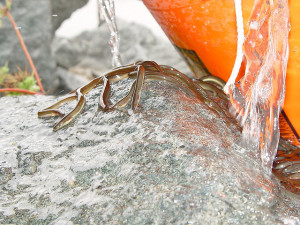This past week has been really informative for me- so many things that I didn’t know about eels, and it turns out that I’m not the only one. Although there are a large number of scientists looking into eel conservation, there are still so many unknowns about eel ecology that it can be hard to figure out what is really going on. For instance, we know that some eel species are diadromous, meaning that they use both marine and freshwater habitats during different parts of their life cycle (Limburg and Waldman 2009), but we don’t know where those species spend their time while at sea (Dannewitz et al. 2005). As a result, we don’t know what conditions those populations are experiencing and how best to support them.

These juvenile eels are moving around obstructions on the Susquehanna River. Photo courtesy of Maryland Fishery Resources Office, USFWS. Link to license
We do, however, have a general sense of the issues facing eels. Most of the studies I found were focused on European, American, and Japanese eels, so I’m going to talk about those species here (although I take my hat off to the researchers in Vanuatu who captured live, venomous sea kraits and made them throw up to do an inventory of local eel species… -check out Reed et al. 2002). One of the big challenges facing species that move between freshwater and saltwater environments is that there can be obstructions like locks and dams (Limburg and Waldman 2009). If the young eels can’t get upriver to appropriate areas, then we start to lose succeeding generations- a study from Ireland found that a hydroelectric station on the River Shannon blocked eel migration upstream so that fish lifts and direct trapping and release above the station were needed, as well as restocking (McCarthy et al. 2008).
The problem with restocking is that we are already over-exploiting some eel populations around the world. Eel is pretty tasty to eat- my first introduction was with sushi and I quickly became a big fan. Eel farming is practiced in a number of areas around the world to help meet demand for this fish, but it turns out that getting eels to successfully reproduce in captivity is very, very difficult (Stone 2003). So eel farmers capture juvenile eels returning to freshwater environments and rear them in ponds– we’re not increasing the number of eels available or creating a farmed population to reduce pressure on wild eels, we’re just moving the eels around, and that’s not really helping eel populations.
And then there are changes in habitats and ecosystems. A study of the upper Mississippi River found that degraded habitats were linked to eel population declines (Phelps, Ridings, and Herzog 2014). When looking at ocean systems, climate change is a real concern. European and American eels in the North Atlantic are very sensitive to changes in the Gulf Stream- some models forecast a weakening and moving Gulf Stream which could have negative consequences for eel migration (Wirth and Bernatchez 2003). We’ve also changed the species they interact with in their environment, sometimes with negative consequences- the introduced swim bladder nematode parasitizes European eels, making them less resistant to stress and compromising their ability to complete long-distance migrations (Fazio et al. 2009).
So eels are facing some big problems- hopefully we are figuring out some solutions. For my next post, I’ll look into strategies for conservation.
Works cited:
Dannewitz J, Maes GE, Johansson L, Wickström H, Volckaert FAM, Järvi T. 2005. Panmixia in the European eel: a matter of time. Proc. Biol. Sci. 272:1129–1137.
Fazio G, Monée H, Da Silva C, Simon-Levert G, Allienne J-F, Lecomte-Finiger R, Sasal P. 2009. Changes in gene expression in European eels (Anguilla anguilla) induced by infection with swim bladder nematodes (Anguillicola crassus). J. Parasitol. 95:808–816.
Limburg KE, Waldman JR. 2009. Dramatic Declines in North Atlantic Diadromous Fishes. BioScience 59:955–965.
McCarthy TK, Frankiewicz P, Cullen P, Blaszkowski M, O’Connor W, Doherty D. 2008. Long-term effects of hydropower installations and associated river regulation on River Shannon eel populations: mitigation and management. Hydrobiologia 609:109–124.
Phelps QE, Ridings JW, Herzog DP. 2014. American Eel Population Characteristics in the Upper Mississippi River. Am. Midl. Nat. 171:165–171.
Reed RN, Shine R, Shetty S, Montgomery WL. 2002. Sea Kraits (Squamata: Laticauda spp.) as a Useful Bioassay for Assessing Local Diversity of Eels (Muraenidae, Congridae) in the Western Pacific Ocean. Copeia 2002:1098–1101.
Stone R. 2003. Freshwater eels are slip-sliding away. Science 302:221–222.
Wirth T, Bernatchez L. 2003. Decline of North Atlantic eels: a fatal synergy? Proc. R. Soc. Lond. B Biol. Sci. 270:681–688.
